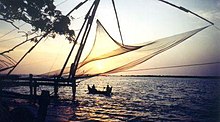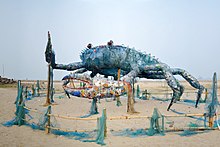Fort Kochi
Fort Kochi
Cochim de Baixo | |
|---|---|
 Fort Kochi | |
| Coordinates: 9°58′05″N 76°14′38″E / 9.968°N 76.244°ECoordinates: 9°58′05″N 76°14′38″E / 9.968°N 76.244°E | |
| Country | India |
| State | Kerala |
| District | Ernakulam |
| Population | |
| • Total | 234,990 |
| Languages | |
| • Official | Malayalam, English |
| Time zone | UTC+5:30 (IST) |
| PIN | 682001 |
| Telephone code | 0484 |
| Vehicle registration | KL-43 |

Fort Kochi, Fort Cochin in English, Cochim de Baixo ("Lower Kochi") in Cochin Portuguese creole, is a locality in the Cochin district of Kerala, India. The locality is 16 km away from Cochin city and takes its name from Fort Manuel of Cochin,[1] the first European fort of the Portuguese East Indies on Indian soil.[2] This is part of a handful of water-bound islands and islets toward the south-west of the mainland Kochi, and collectively known as Old Cochin or West Kochi. Adjacent to this is Mattancherry. In 1967, these three municipalities, along with a few adjoining areas, were amalgamated to form the Corporation of Cochin.
Scientific theory[]
In the BC period, the region that is today known as Kerala was covered by mangrove woods. Turf and sand banks were created with the rise in sea-level which formed the shape of the coastal area as we see it today. The name Cochin implies "co-chin", meaning "like-China".[citation needed] It looked like China when the Chinese came to the region during the 14th century and installed Chinese nets. Mattancherry is the nerve town of old historic Cochin. In old Malayalam it is Maadan-cheri, from cheri meaning town. Maad or cow was the stamp of Old Royal Fort of Rajah of Cochin, who built his palace after the fall of Kodungallur or Muziris port due to a gigantic tsunami in 1341 AD.[citation needed] The Perumpadappu Swaroopam or the Fort of Rajah had its palace on the banks of the Calvathy River. Owing to frequent wars between King Zamorin of Kozhikode and the western colonial forces, the Rajah left the place for Tripunithura. The king had his vaishnav leanings and the cow or maadu was his symbol.
Connectivity[]
Fort Kochi can be accessed from Ernakulam through roadways and water ways. Private buses and government transport buses travel from different parts of the city to Fort Kochi. Owing to the high volume of tourists visiting the place dedicated low floor Volvo buses were introduced to this route by the government. Such buses are in use on the popular routes such as Cochin International Airport (CIAL), Vytila Mobility Hub and Kakanad Info Park.
History[]

The port at Kozhikode held superior economic and political position in medieval Kerala coast, while Kannur, Kollam, and Kochi, were commercially important secondary ports, where the traders from various parts of the world would gather.[3] Fort Kochi was a fishing village in the Kingdom of Kochi in the pre-colonial Kerala. The Portuguese arrived at Kappad Kozhikode in 1498 during the Age of Discovery, thus opening a direct sea route from Europe to India.[4] The territory that would be later known as Fort Kochi was granted to the Portuguese in 1503 by the Rajah of Kochi, after the forces of Afonso de Albuquerque helped him fighting the forces of Saamoothiri of Kozhikode. The Rajah also gave them permission to build Fort Emmanuel near the waterfront to protect their commercial interests. The first part of the name Fort Kochi comes from this fort, which the Dutch later destroyed. The Portuguese built their settlement behind the fort, including a wooden church, which was rebuilt in 1516 as a permanent structure, today known as the St Francis Church. Fort Kochi remained in Portuguese possession for 160 years. In 1683 the Dutch captured the territory from the Portuguese, destroyed many Portuguese institutions, particularly Catholic including convents. The Dutch held Fort Kochi in their possession for 112 years until 1795, when the British took control by defeating the Dutch. Foreign control of Fort Kochi ended in 1947 with the Indian independence.




A mix of old houses built by the Portuguese, Dutch and British in these colonial periods line the streets of Fort Kochi. St Francis Church was built in 1503 by the Portuguese as a Catholic church. Vasco da Gama was once buried in this church which now falls under the Church of South India and is one of the national monuments. Santa Cruz Basilica, also built by the Portuguese in the 16th century, was later destroyed by the British and rebuilt near the end of 19th century.[citation needed] From this period there are other residential buildings and hotels such as the Old Harbour House, some of which have been renovated in more recent times. The landmark that causes more public and visitor interest is a series of precolonial Chinese fishing nets on the waterfront, believed to have been introduced by Chinese traders in the early 14th century.
First sources[]
Since the beginning of the Common Era, Arabian and Chinese traders sourced spices, especially pepper, cinnamon, cardamom, cloves, sandal wood, etc. from the Kochi region. Cultivation and trade of these valuable goods shaped the history of the region. Even today, Kochi is an important centre of spice export. The Arabian traders were the first to know about these spices, and they carried the highly wanted merchandise to Europe. Centuries later, they were followed by the Portuguese, then the Dutch, and afterwards the British.
Around 600 AD[]
Written documents about the Malabar Coast show that this region had Hindus, Christians, and a Jewish minority.[5]
Around 1341[]
The natural harbour of Kochi was created by a flood that also destroyed the harbour of the town Kodungallur. Thereafter, the town developed into one of the most important harbours on the West Coast of India. It concentrated on the spice trade with China and the Middle East.
Around 1500[]
During this period, Calicut was ruled by king Zamorin and Kochi was ruled by the Maharaja of Cochin. This was the time when the first Portuguese ships berthed at the Malabar Coast: Vasco da Gama in Calicut and Pedro Álvares Cabral in Kochi. The Maharaja of Kochi felt threatened by the Zamorin of Calicut, and he hoped that the Portuguese would help him in his defense from the neighbouring king of Calicut. The Maharaja welcomed the Portuguese, and they founded their first trading center in Kochi. However, the Maharaja of Cochin was largely deprived of his power, and Kochi became the first European colony in India.[citation needed] The Portuguese put pressure upon the small Jewish community, and even the Syrian Christians as they were practising Nestorianism. The Portuguese tried to merge the Syrian Christian Church with the Latin Church. This created conflict as most of the Syrian Christians were associated with various churches of the East and rejected the authority of the Pope and the Latin Church. Francis Xavier also converted several thousand. Thus the Christian population increased in Kochi.[6]
Around 1663[]
At the invitation of a deposed prince of Cochin Royal Family and the hereditary Prime Minister of Cochin, namely the Paliath Achan, the Dutch came to Cochin and conquered Kochi in 1663. The town became the capital of Dutch Malabar and belonged to the worldwide trading network of the Dutch East India Company. The Dutch also destroyed many Catholic institutions in Cochin.[7]
Around 1760[]
There came uneasy times for Kochi because of trouble between the regional powers. Kochi was devastated by Hyder Ali, then later by his son Tipu Sultan. Tipu Sultan subordinated the town temporarily to the kingdom of Mysore.
Around 1790[]
Kochi came under the influence of the British around this period. In 1814, Kochi became a part of the Madras Presidency becoming a part of the British colonial empire. The British shaped the country until the 20th century, and Kochi has always been an important harbour and trade center.
Around 1860[]
The municipality of Fort Kochi was formed on 1 November 1866 according to the Madras Act 10 of 1865 (Amendment of the Improvements in Towns act 1850)[8][9][10][11] of the British Indian Empire, along with the municipalities of Kozhikode, Kannur, Thalassery, and Palakkad, making them the first modern municipalities in the modern state of Kerala, as a part of the Malabar District.
1947[]
Kochi was made the capital of the Union State Cochin after India gained independence.
1956[]
The Union State of Kerala was created with respect to the Malayalam speaking regions with Trivandrum as the capital. In 1956 the first free elections were held and the Communist Party formed the first government of Kerala, the first freely elected communist government in the world.[citation needed]
Main Tourist Attractions[]



- Cochin Carnival
- Indo Portuguese museum
- Chinese fishing nets
- Fort Kochi beach
- Promenade with fresh sea breeze
- Dutch Cemetery
- Southern Naval Command Maritime Museum
- Cochin Thirumala Devaswom
- Sree Gopalakrishna Devaswom Temple (The Only Daivajna Brahmin Temple in Kerala)
- Koonan Kurish Old Syrian Church
- St. Francis Church
- Santa Cruz Basilica
- Bishop's House
- Fort Emmanuel
- Jewish Synagogue
- Mattancherry Palace
- Jain Temple
- Kochi-Muziris Biennale
References[]
- ^ https://web.archive.org/web/20191212225025/http://www.vascohomestay.com/fort_cochin.html
- ^ "THE MELTING POT OF CULTURES". Kimansion. Retrieved 25 June 2016.
- ^ The Portuguese, Indian Ocean and European Bridgeheads 1500–1800. Festschrift in Honour of Prof. K. S. Mathew (2001). Edited by: Pius Malekandathil and T. Jamal Mohammed. Fundacoa Oriente. Institute for Research in Social Sciences and Humanities of MESHAR (Kerala)
- ^ DC Books, Kottayam (2007), A. Sreedhara Menon, A Survey of Kerala History
- ^ The Jews of India: A Story of Three Communities by Orpa Slapak. The Israel Museum, Jerusalem. 2003. p. 27. ISBN 965-278-179-7.
- ^ "Cochin History". Cochin.org. Retrieved 25 June 2016.
- ^ "Fort Kochi". Travel India. Retrieved 25 June 2016.
- ^ "CHRONOLOGICAL LIST OF CENTRAL ACTS (Updated up to 17-10-2014)". Lawmin.nic.in. Retrieved 7 August 2016.
- ^ Lewis McIver, G. Stokes (1883). Imperial Census of 1881 Operations and Results in the Presidency of Madras ((Vol II) ed.). Madras: E.Keys at the Government Press. p. 444. Retrieved 5 December 2020.
- ^ Presidency, Madras (India (1915). Madras District Gazetteers, Statistical Appendix For Malabar District (Vol.2 ed.). Madras: The Superintendent, Government Press. p. 20. Retrieved 2 December 2020.
- ^ HENRY FROWDE, M.A., Imperial Gazetteer of India (1908–1909). Imperial Gazetteer of India (New ed.). Oxford: Clarendon Press. Retrieved 2 December 2020.CS1 maint: date format (link)
External links[]
| Wikimedia Commons has media related to Fort Kochi. |
- A short YouTube video visualizing areas to be visited in and around Fort Kochi
- The Great Fire of Cochin 1889 - Article by The Hindu
- Fort Kochi, Its History and Culture - TranspireOnline
This article needs additional citations for verification. (January 2017) |
- Neighbourhoods in Kochi
- Tourist attractions in Kochi
- Regions of Kochi
- Suburbs of Kochi
- 1503 establishments in the Portuguese Empire
- Tourist attractions in Ernakulam district


